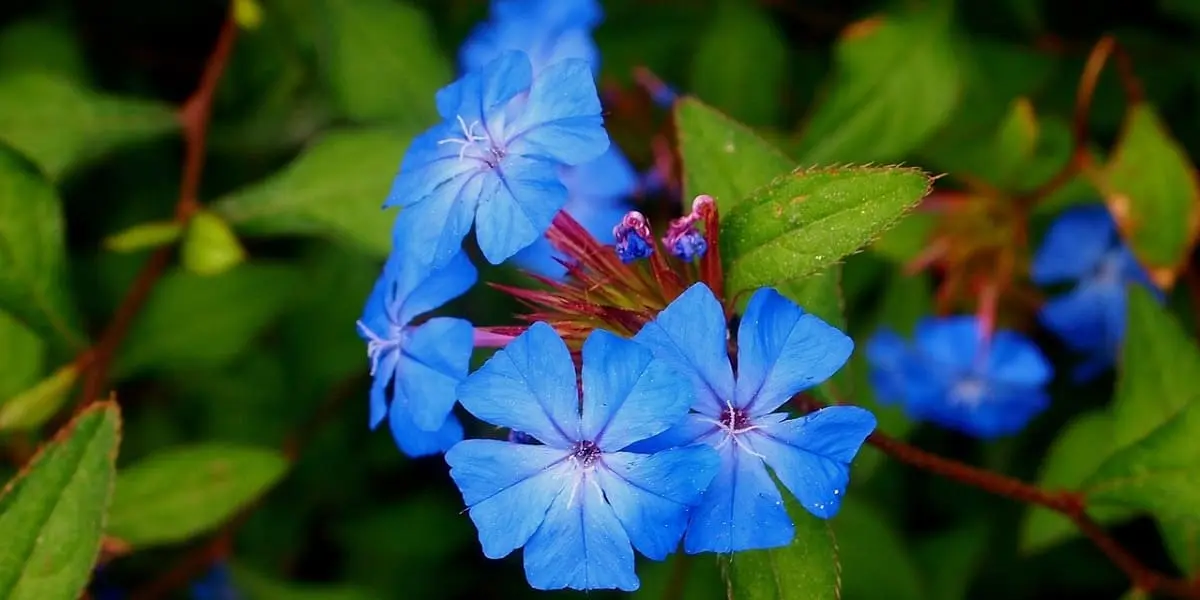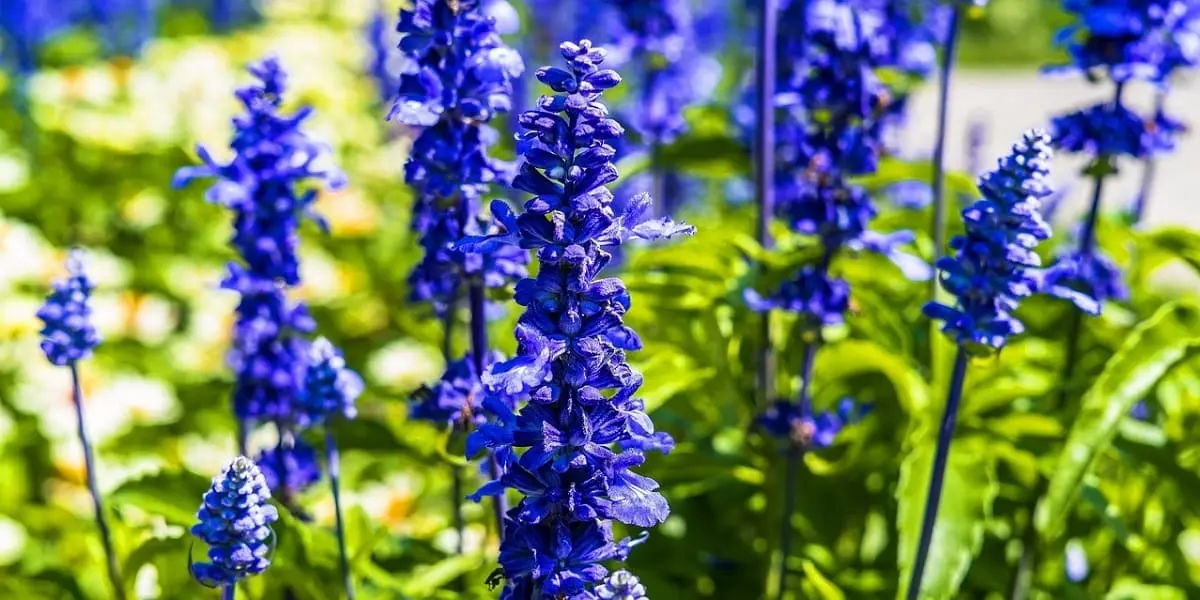Content
Blue thistle

Blue thistle blooms between July and October, it is a hardy flower, simple to grow and low maintenance. You can pick them and make pretty bouquets by drying them. Sunny or slightly shaded areas of the garden are the best places to grow blue thistle. The plant is undemanding and will grow in any type of soil, whether stony or chalky, so it doesn’t need fertilizer or compost, but it’s important that the soil be well-drained. Plant blue thistles in loose, well-drained soil in the fall to enjoy their beautiful summer flowers, they can also be planted in the ground in the spring. A limit of 5 feet per square foot allows each plant to have enough room to grow, for a wilder effect feel free to plant it in the middle of a bed.
Clematis

Clematis is a climbing perennial that produces decorative blue flowers. It can be grown both in a garden and in pots indoors. Very easy to grow, they are mainly used in landscaping and in the decoration of porches, patios and gardens. Decorate your garden between June and September depending on the variety.
Hydrangea

The hydrangea is a flowering shrub that will enchant your garden with its bloom from June to October. It begins with buds that open into large, beautiful pink or blue spheres. Its decorative foliage is adorned with brilliant colors in the fall. Easy to grow, the hydrangea promises to bring sweetness and romance to your garden.
Place the hydrangea in a sheltered spot in the shade with enough light but not in full sun which could burn the plant. Hydrangea is a hardy plant that can withstand temperatures below -15°C, you can cover it with a veil in winter to protect it in case of very strong frost.
Plant your hydrangeas when the weather is mild, preferably in early fall or spring. Hydrangeas prefer acidic to calcareous soils, so combine garden soil and heather soil, to which you can add compost and sand.
If you plan to plant several hydrangeas, make sure to space them sufficiently (about one meter). Then dig the planting hole, which should be three times as large as the root ball. To help keep the soil cool, place a layer of organic mulch at the base of the plant. Finally, water your hydrangeas generously over the next few weeks.
Hydrangeas need relatively cool soil, so water regularly throughout the summer, especially during dry spells. If it is grown in a pot, it will need to be watered more frequently, as the substrate dries out more quickly than in the ground. Be sure to drain off standing water to prevent the roots from being in an overly humid environment.
To stimulate the flowering of the hydrangea, you can add a fertilizer for heather plants that will make the soil more acidic and fertile.
Pruning hydrangea keeps it healthy and improves the quality of its bloom. You can do this every year in the fall and late winter. In the fall, prune lightly to protect it from possible frosts. Prune more heavily at the end of winter to promote fall bloom.
Iris

The iris is an ideal perennial plant to decorate a garden. Depending on the variety, it blooms from February to fall. There are many species for every type of garden, from large, colorful irises for sunny beds to mini irises for planting in wet areas or near a water feature.
Bulbous or rhizome, irises are easy to grow in sunny parts of the garden and can also be used in planters on a balcony.
Bulbous irises are usually planted in September in soil that is free of stones and enriched with compost (water if the soil looks dry). Plant the iris bulbs 10 cm deep, spaced about 20 cm apart, and then cover the bulbs without packing them. Bulbous irises can also be grown in pots, in which case you should use large containers and plant the bulbs 10 cm deep and use potting soil lightly enriched with compost.
The rhizome iris or garden iris is planted in spring, choose a sunny place and a well-drained soil.
For rhizome irises, choose small varieties and place the iris rhizomes halfway up in fine, soft soil and ensure good drainage at the bottom of the planter. Finally, place the planters in a sunny spot in your garden or patio.
Cut the flowers at the end of their cycle, without touching the leaves, to allow the plant to replenish its reserves. Cut off only the damaged ones and divide the rhizomes if the iris seems less flowery.
Irises do not need to be watered if the soil is well drained and the location is sunny. As for fertilizer, except for a small amount at planting, it is not necessary to add any.
As irises have a relatively short flowering period, choose remontant varieties to enjoy spring and summer blooms.
Hyacinth

Hyacinths are beautiful bulbous flowers that add a touch of color and fragrance to your garden. They usually grow in the spring and come in a wide variety of colors, including blue, purple, pink and white.
The best time to plant hyacinths in your garden depends on your climate. In areas with cold winters, it is recommended that hyacinth bulbs be planted in the fall, sinking them into the ground about 8 cm deep and spacing them about 15 cm apart. In areas with milder winters, you can wait until early spring to plant your bulbs.
To care for your hyacinths, be sure to plant them in well-drained, nutrient-rich soil. They need plenty of sunlight to bloom optimally, so be sure to plant them in a sunny or partially shaded area. During the growing season, be sure to water them regularly to keep the soil moist, but avoid submerging them.
Hyacinths, with their beautiful color and delicate fragrance, will add a touch of charm and beauty to any garden. If you take care to plant and maintain them properly, you will enjoy their beauty every spring.
Forget-me-not

Forget-me-nots, also known as pansies, are small herbaceous flowers belonging to the Boraginaceae family. They are primarily known for their bright blue color, but can also be found in purple, pink, white and yellow.
Forget-me-nots are ideal for gardens because they bloom profusely in spring and summer. They are also easy to grow and maintain, making them a great option for beginning gardeners. To plant forget-me-nots, simply sow them in the fall or early spring in well-drained, nutrient-rich soil. You can also buy forget-me-not plants and transplant them into your garden.
To care for your forget-me-nots, be sure to plant them in a sunny or partially shaded area and water them regularly to keep the soil moist. If you notice that the flowers are starting to fade, cut them back to encourage new growth. Forget-me-nots are also susceptible to disease and pests, so be sure to monitor them regularly for any problems.
Forget-me-nots are a great option for adding color and decoration to your garden. They are easy to grow and maintain, and bloom profusely in spring and summer. If you take care to plant and maintain them properly, you can enjoy their beauty every year.
Periwinkle

Periwinkles are beautiful herbaceous flowers belonging to the Gesneriaceae family. They are known for their beautiful blue or purple color and dark green foliage, and are often used to add color and decoration to flower gardens.
There are many species of periwinkle, but the most common are the Madagascar periwinkle and the African periwinkle. The Madagascar periwinkle is a perennial that blooms in summer and needs lots of sun to thrive. The African periwinkle, on the other hand, is an annual plant that blooms year-round.
To plant periwinkle in your garden, you can either buy seedlings or seeds and sow them depending on your climate. Periwinkles need lots of sun and warmth to bloom, so be sure to plant them in a sunny or slightly shady area. Also be sure to plant them in well-drained, nutrient-rich soil, and water them regularly to keep the soil moist.
Periwinkles are a great idea for adding color and decoration to your garden. They are easy to grow and maintain and can bloom year-round, depending on the species you choose. If you take care in planting and maintaining them, you can enjoy their beauty for many years to come.
Rhododendron

Rhododendrons are large ornamental shrubs belonging to the Ericaceae family. They are known for their large, dome-shaped flowers and lush foliage, and are often used to add color and decoration to flower gardens.
There are many species of rhododendron, each with its own characteristics in terms of color, shape and size of the flowers. Rhododendrons usually bloom in May and June, and come in a wide variety of colors, from white to pink to blue to purple.
To enjoy the beauty of rhododendrons, it is recommended that they be planted in the fall or early spring in well-drained, nutrient-rich soil in a sunny or partially shaded area. Rhododendrons need a lot of water, so be sure to water them regularly to keep the soil moist.
Sage

Sage is a fairly hardy plant that can easily fit into many gardens. It is perfect for adding color and texture while being very easy to maintain. It is also known for its medicinal properties and culinary uses. This dwarf leafy plant can be easily transplanted and acclimates to light, well-drained soil. It can also be grown in pots. Sage is a flower that brings vitality to your garden and its blue or purple flowers offer beautiful colorful highlights. It is also very resistant to disease and pests, making it an ideal plant for any gardener.
Volubilis

Volubilis are climbing plants belonging to the Fabaceae family. They are very popular for their multitude of flowers and bright colors. They are often used to dress up walls, trellises, grills and even flower beds and greenhouses, making them an asset to any garden.
Volubilis are very easy to care for and can grow very quickly, making them an ideal ornamental plant. They can be pruned and will always maintain their shape and appearance. They prefer well-drained soil and a sunny location. They also do not require much watering and are very resistant to disease and pests.
Volubilis are also very flexible and will enjoy all sorts of plant combinations in the same garden. They add height and texture to all kinds of plants and plant formations. If you are looking to create a natural and attractive setting for your gardens, volubilis are a great choice!
- Discover also
- How to fill a swimming pool?
